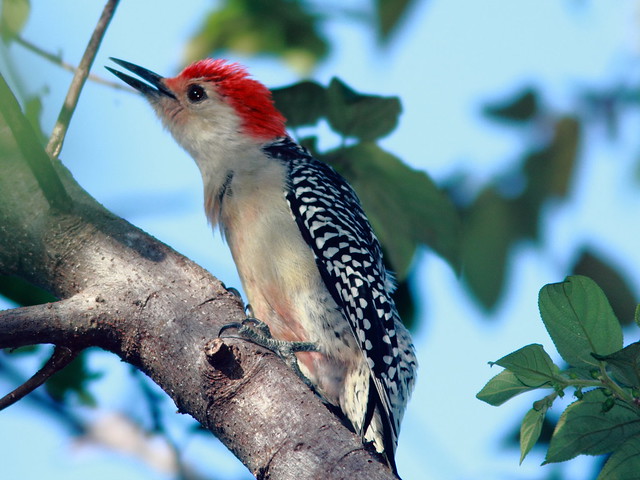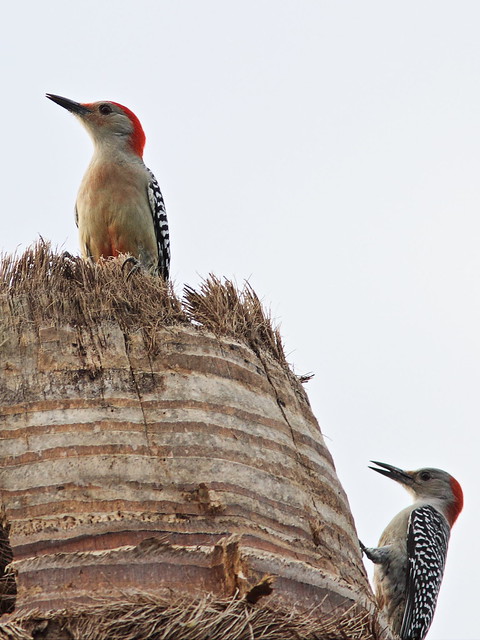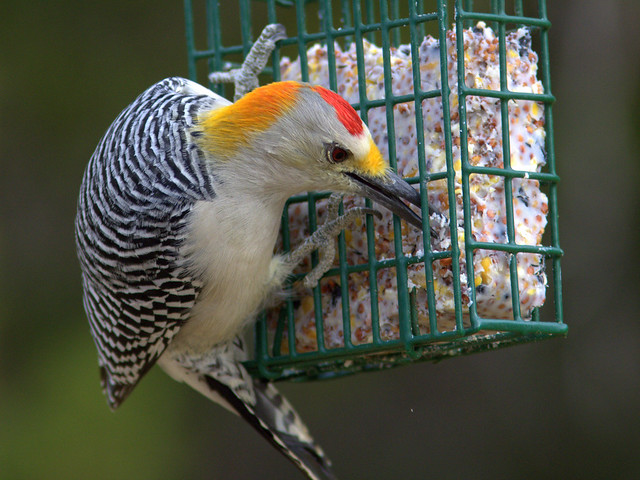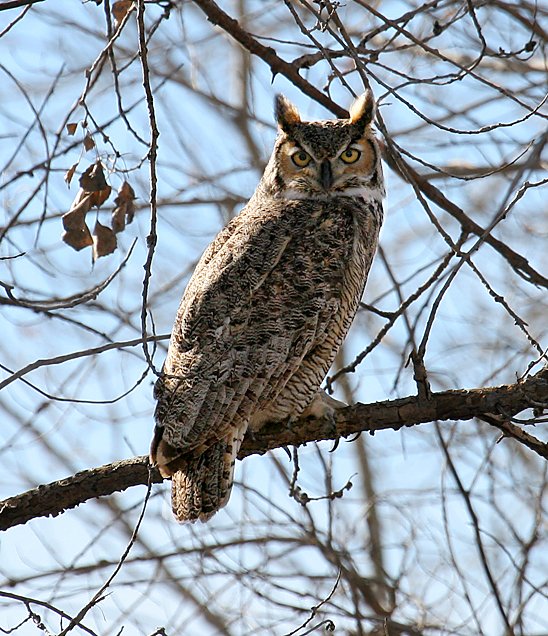You must look closely to see the red belly on one of these woodpeckers. As a child growing up in New Jersey I had little hope of ever encountering a Red-bellied Woodpecker. They were birds of the south, although they had been seen uncommonly in the area of Long Island around the middle of the nineteenth century. One showed up in Central Park, New York in 1909, and there were only four other records in the greater New York/New Jersey area through 1940.
For some unknown reason they started returning in the in the late 1950s, reaching my area of northern New Jersey only a few years after I left for good when I got drafted into the service in 1966. Now they are abundant all over the Garden State, as they are in our present home in south Florida.
They are handsome birds. The male has a conspicuous red area on the top of his head that extends from nape to forehead.

Sometimes you can even see his red "belly."

This male is visiting a feeder at National Audubon's Corkscrew Swamp Sanctuary.

They are gregarious, often seen in small family groups and more often heard than seen, as this homeowner will attest as one drums loudly on the rain gutter.

The red area on the female's head is limited to the nape.

Here a pair explores the top of a dead Royal Palm in our neighborhood wetlands.

I came upon this one while he was sunbathing. As I watched he started scratching and then rubbing his head against a branch before flying off.

The related Golden-fronted Woodpecker ranges from Texas down into Mexico. The two species overlap in central Texas. This one visited a feeder in Palo Duro Canyon in the Texas Panhandle. It is a particularly beautiful bird.


A third similar species, the Gila Woodpecker, is restricted to the arid southwestern US-- southern Arizona and extreme southern California. It looks like a drab version of the Red-bellied. The red is confined to a small patch atop the head of the male. I photographed this one in the Arizona Sonora Desert Museum in Tucson.

The Gila Woodpecker favors Saguaro Cactus, in which they excavate unique cavities in the spiny plant's soft wet pulp. They must wait several months for the walls to dry into a durable hard enclosure.

Today is the tenth anniversary of my father's death at the age of 95. Yesterday, thinking about this drove me to reflect upon the shrinking wild areas near my childhood home in Rutherford, New Jersey. When I was quite small Dad would often take me for "nature walks," as we called them. I eagerly anticipated those Saturday mornings and was disappointed when it rained or when other obligations got in the way.
So I fired up Google Earth to see if anything was left of those places. Two in particular were small pockets of wetland that sometimes held water all summer and even attracted nesting Mallards. Using Google Street View I "walked" from our home on Springfield Avenue west on Cooper Place, down the hill on what was a cobblestone road but now is paved with asphalt. Most of the frame homes still looked familiar.
I "crossed" busy Jackson Avenue, and made a dogleg turn to the left and then west again on Hastings Avenue. No longer a dirt road that narrowed into a winding path, it was neatly paved, lined with apartments and ended in a cul-de sac, ringed with upscale living units that overlooked the Passaic River. The river was now contained behind bulkheads and its sharp edges neatly landscaped.
Dreams are weird. Last night I dreamed I was a child walking that path, all the way through "Charlie's Woods," past the pond with the "warbler tree," to the banks of the river. I was with another kid, my cousin Corky, I think. Yet I somehow was also in the present, as I knew that Dad and Corky were long gone and that I lived in Florida. I awoke thinking about blogs I wrote about those days. The first is an excerpt written eight years ago, and the second on the third anniversary of Dad's death.
* * * * *
 On Saturday mornings, Dad would often take me on walks over to the west side of Jackson Avenue, a wooded strip a quarter to a half mile wide that extended to the Passaic River. In the winter, we followed the tracks of rabbits and mice in the snow. Once we saw the dramatic record of an encounter between a rabbit and a large bird of prey, probably an owl. The rabbit’s tracks ended suddenly in a disturbed area that showed the imprint of wing feathers and a little blood. At Dad’s funeral, I talked about how special those memories were to me. Maybe he knew, too, but I never told him directly.
On Saturday mornings, Dad would often take me on walks over to the west side of Jackson Avenue, a wooded strip a quarter to a half mile wide that extended to the Passaic River. In the winter, we followed the tracks of rabbits and mice in the snow. Once we saw the dramatic record of an encounter between a rabbit and a large bird of prey, probably an owl. The rabbit’s tracks ended suddenly in a disturbed area that showed the imprint of wing feathers and a little blood. At Dad’s funeral, I talked about how special those memories were to me. Maybe he knew, too, but I never told him directly.
New Jersey in springtime was one of the greatest places to see beautiful and colorful migrant birds such as warblers, orioles and tanagers. Even before their leaves fully opened, trees would be alive with warblers of many species. Rutherford now is but a ghost of the birding paradise my friends and I trudged in the 1940s and 50s. My logs refer to the extensive sand dunes along the Passaic River, where cuckoos nested and shrikes impaled insects on thorny twigs. Barn Swallows nested on the abutments of the Union Avenue Bridge (Postcard view to the right). Two spots were especially famous for their variety of birding habitats: “Charlie’s Woods” and “Strinchuck’s Pond.” All are now gone, converted into homes and apartments.
tanagers. Even before their leaves fully opened, trees would be alive with warblers of many species. Rutherford now is but a ghost of the birding paradise my friends and I trudged in the 1940s and 50s. My logs refer to the extensive sand dunes along the Passaic River, where cuckoos nested and shrikes impaled insects on thorny twigs. Barn Swallows nested on the abutments of the Union Avenue Bridge (Postcard view to the right). Two spots were especially famous for their variety of birding habitats: “Charlie’s Woods” and “Strinchuck’s Pond.” All are now gone, converted into homes and apartments.
One day my cousin Corky and I caught a batch of “frogs” in Strinchuck’s Pond. We killed and skinned them and fried their legs on a piece of rusty tin with a little bacon. They tasted just fine. Yet they may actually not have been frogs at all, but toads! One spring we caught hundreds of garter snakes. We stuffed them into our pockets and into a bucket we found, intending to release all of them in my backyard. I forgot about the ones in my pockets and they turned up in the washing machine, to Mom’s horror.
We were attuned to the smells of the woods as the seasons changed. Skunk Cabbage was easy to detect in early spring. As the earth warmed we could smell the garter snakes as they came out of hibernation and began mating. Around mid-August there was a particular type of small red ant that gave off a kind of perfume as the winged adults emerged. They had a bitter-sweet taste (the front 2/3 were bitter and the rear 1/3 quite sweet). Yes, we ate some crazy things, but these ants actually smelled good enough to eat, so we tried.
Several of my childhood friends shared my interest in birds. We grew up together, some from kindergarten right through high school. We gradually came to realize that the larger world did not look as kindly upon people who walked around with binoculars. As we advanced in age and wisdom, we found it prudent not to be labeled as “bird watchers.” There were fewer opportunities for group birding. Solitary bird watching did not appeal to me. Competing and collaborating with others to spot and identify bird species is energizing. Seeing new places was not as much fun alone as it was when there was someone to share the experience. I resolved that when I married, it would be to a birdwatcher.

I became a sneaky birder. No one around me knew how happy I was to finally see my first mockingbird (more recent photo above) when I attended a wedding in Maryland. My birding activities ebbed to an all-time low through college and medical school, but picked up after I went into private practice in Bloomfield, New Jersey. Dr. Adrian Sabety, a local surgeon colleague, was an expert birder. We made time to get out to bird locally, if only briefly. We often visited the nearby Watchung Mountains, where hawks congregated during migration. It seemed only a few people even knew about it, but it was to become quite a famous hawk-watching spot.
* * * * *
 My fondest memories of childhood were not those of solitary pursuits. Not having someone there to share an otherwise awesome event seems to take the edge off the experience. Maybe it’s because I simply want to say, “Hey, look at that!” and feel the satisfaction of having another appreciate and later reiterate the experience. Frequently, it works the other way. So many times I might have missed what another pointed out or interpreted.
My fondest memories of childhood were not those of solitary pursuits. Not having someone there to share an otherwise awesome event seems to take the edge off the experience. Maybe it’s because I simply want to say, “Hey, look at that!” and feel the satisfaction of having another appreciate and later reiterate the experience. Frequently, it works the other way. So many times I might have missed what another pointed out or interpreted.
I feel some sadness when I see parents showering their children with expensive gifts and elaborate parties. How often are the kids more fascinated with the packing crate than the contents? Yes, that Christmas when I received the full-sized balloon-tired two-wheeler persists in my memory, but I smile and relax when I think of those woodland walks with my father. The day we encountered a young Great Blue Heron who could not become airborne because it was trapped among dense trees along the Passaic River—how Dad covered its head and mean-looking beak with his jacket so we could carry it out into an open field—the thrill of seeing the bird slowly rise on untried wings…
One Spring I attended a week-long medical refresher course at the YMCA of the Rockies in Estes Park, Colorado. I invited my parents to join us, and they flew to Dallas. Mary Lou and I and our four children set out with them in our 1972 Oldsmobile Custom Cruiser station wagon. Despite the demands of the curriculum, we found time to walk the trails and see deer, beavers, American Dippers and a family of Blue Grouse (now known as Dusky Grouse).
 We had followed a direct route to Colorado, but after the conference I took leave for a few days to permit a more leisurely trip back to Texas. On the return leg, we spent two nights at Kachina Lodge in Taos, New Mexico.
We had followed a direct route to Colorado, but after the conference I took leave for a few days to permit a more leisurely trip back to Texas. On the return leg, we spent two nights at Kachina Lodge in Taos, New Mexico.
The first night we watched Pueblo Indian dances, and the next morning we attended Sunday Mass at San Francisco de Asis in Ranchos de Taos. This adobe church, completed in 1815, is said to be the most photographed church in America. (Dad loved the old churches of New Mexico. The photo shows him, on the right, with his brother, Father Dan, on the High Road to Taos, visiting the church at Truchas/Las Trampas).
The ceremony was entirely in Spanish. It happened to be Father’s Day. The priest invited all fathers to join him on the altar to recite the Lord’s Prayer. Dad and I walked up and joined the congregation in prayer. I knew some Spanish, but Dad knew none. That did not dissuade him. He put his hand on my shoulder and launched into the Latin version of the prayer. While everyone else was saying “Padre nuestro que estás en los cielos, santificado sea tu nombre…” Dad was confidently announcing “Pater noster qui es in coelis, sanctificetur nomen tuum.” The Romance cadences were so similar that no one seemed to notice. That Father’s Day and all others afterwards held special significance for me.
During my working years I enjoyed beating the traffic and getting to the office early. I was able to close my office door and organize my day in peace and quiet before my co-workers appeared. When I retired from active duty I resolved never to sleep late. Therefore, when we moved to the mountains of New Mexico I set the alarm on my watch for 7:30 AM to nudge me awake just in case, but I rarely needed it. Dawn came quick and bright as the sun emerged in a blue sky above the ridge to the east.
So it happened that on Sundays, 7:30 AM Mountain Time was an ideal time for me to call my father, back home in New Jersey. By then he had returned home from early Mass and had finished his breakfast, and was in the middle of his morning papers. The chirp of my watch alarm was a gentle reminder, and rarely did I miss placing the call. If I happened to be a little late, he would ask about the reason for the delay. At Dad’s funeral, his younger brothers told me how important those calls were to him. Unbeknown to me, he arranged his Sunday morning schedule to accommodate my call.
We talked about nothing in particular, though we often filled the greater part of an hour with banter. Embedded among discussions of the weather, politics and sports were those “I wish you could have seen…” and “Remember when we…” moments that swept us back to those earlier days.
I last called Dad only a few days before he died. He spoke of how wonderful it was to have a hospital room with a view.
Now in the Eastern Time Zone, my wristwatch still chirps at 7:30. Though two hours earlier in real time, the sun already dapples on the surface of our lake. And I whisper a Pater Noster in remembrance.















